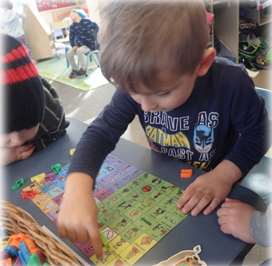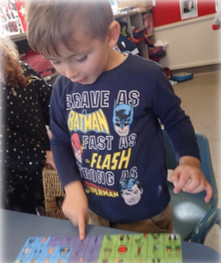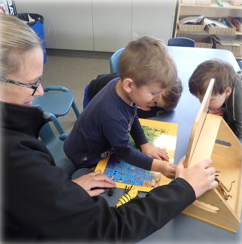Early Childhood AAC use - George playing with bugs
This is the second of three amazing learning stories to share with you from a young AAC user, George*, who was on our waitlist at the time they were written. George’s Ministry of Education Speech Language Therapist worked with his Early Childhood Education provider to implement a range of low & mid-tech AAC tools to help support his communication. They used a 77 location core vocabulary board, a Big Point, a Go Talk and eventually progressed to a more comprehensive communication book with a core vocab fold out. George is now undergoing a high-tech assessment and already has such fantastic AAC skills thanks to his dedicated team who supported his AAC journey from such a young age. *name changed to maintain confidentiality. Stories and photos shared with permission from the whānau and kaiako.
*name changed to maintain confidentiality. Stories and photos shared with permission from the whānau and kaiako.
Bugs Bugs Bugs!
Today George we were working with your core board, to support you with your communication goal; of developing your verbal communication skills to be an effective communicator (korerorero), to express your feelings, to negotiate, create and retell stories, to communicate information and solve problems when playing alongside your friends (nga hoa) and teachers (kaiako).
We had a wonderful time together posting the ngārara (insects) in and out of the puppetry box. This was a great way for you to learn the position and meaning of the pecs cards on the core board. Every time we posted a ngārara, we would point to the ngārara then we would point to the “in or out” icons. Pointing to the “I, want, put, in or out” icons this proved to be extremely successful in demonstrating what the icons represented. Several children started to gather around us George, as we were playing a “game” with the resources, and they could here you laughing.
George you taught the children how to “play” the game. Then the children took over my role and together you played “insects in and out”, for the next thirty minutes. However the only way that you got the bugs out was to point to the icons. Sometimes you would try to cheat! This was when the ripples of laughter would start erupting from you. Cheeky!!! Your peers were extremely helpful being consistent in using the board supported with the words verbally as well.
It was fabulous titro titro (watching) you korerorero (communicating) effectively with the other tamariki (children) by placing the ngārara in and out through the holes. When it was time to tidy up you were very sad. After lunch however I pulled out the ngārara and puppet stand again and you invited your nga hoa, to come and join you posting the insects in and out of the holes. This was achieved by physically tapping ngã tamariki on the pokohiwi (shoulder) and pointing to the ngārara on the tepu (table). George it was great to observe this co-operative play alongside your peers using the communication tool. I feel introducing the tawa (purple) icons on your core board through play in a meaningful way, is going to support you in consolidating these icons, so that you can use them in other play scenarios.
George I will continue to use the core board with you in play scenarios and will also introduce the Jolly Phonics signs and sounds within the Prep School.
 |  |
 |  |
 |
“I want put in…”
George pointing to the icons independently!
“I want take out…”
George pointing to the icons independently
George your friends were really intrigued to see how to use your core board, and were keen to use it with you! It wasn’t long before my role as kaiako was redundant and your peers worked with you using your core board!
George’s patience and perseverance using the core board has increased immensely. George is very excited taking his board out in the mornings ready to use it with both kaiako and tamariki!
This is the second of three amazing learning stories to share with you from a young AAC user, George*, who was on our waitlist at the time they were written. George’s Ministry of Education Speech Language Therapist worked with his Early Childhood Education provider to implement a range of low & mid-tech AAC tools to help support his communication. They used a 77 location core vocabulary board, a Big Point, a Go Talk and eventually progressed to a more comprehensive communication book with a core vocab fold out. George is now undergoing a high-tech assessment and already has such fantastic AAC skills thanks to his dedicated team who supported his AAC journey from such a young age. *name changed to maintain confidentiality. Stories and photos shared with permission from the whānau and kaiako.
*name changed to maintain confidentiality. Stories and photos shared with permission from the whānau and kaiako.
Bugs Bugs Bugs!
Today George we were working with your core board, to support you with your communication goal; of developing your verbal communication skills to be an effective communicator (korerorero), to express your feelings, to negotiate, create and retell stories, to communicate information and solve problems when playing alongside your friends (nga hoa) and teachers (kaiako).
We had a wonderful time together posting the ngārara (insects) in and out of the puppetry box. This was a great way for you to learn the position and meaning of the pecs cards on the core board. Every time we posted a ngārara, we would point to the ngārara then we would point to the “in or out” icons. Pointing to the “I, want, put, in or out” icons this proved to be extremely successful in demonstrating what the icons represented. Several children started to gather around us George, as we were playing a “game” with the resources, and they could here you laughing.
George you taught the children how to “play” the game. Then the children took over my role and together you played “insects in and out”, for the next thirty minutes. However the only way that you got the bugs out was to point to the icons. Sometimes you would try to cheat! This was when the ripples of laughter would start erupting from you. Cheeky!!! Your peers were extremely helpful being consistent in using the board supported with the words verbally as well.
It was fabulous titro titro (watching) you korerorero (communicating) effectively with the other tamariki (children) by placing the ngārara in and out through the holes. When it was time to tidy up you were very sad. After lunch however I pulled out the ngārara and puppet stand again and you invited your nga hoa, to come and join you posting the insects in and out of the holes. This was achieved by physically tapping ngã tamariki on the pokohiwi (shoulder) and pointing to the ngārara on the tepu (table). George it was great to observe this co-operative play alongside your peers using the communication tool. I feel introducing the tawa (purple) icons on your core board through play in a meaningful way, is going to support you in consolidating these icons, so that you can use them in other play scenarios.
George I will continue to use the core board with you in play scenarios and will also introduce the Jolly Phonics signs and sounds within the Prep School.
 |  |
 |  |
 |
“I want put in…”
George pointing to the icons independently!
“I want take out…”
George pointing to the icons independently
George your friends were really intrigued to see how to use your core board, and were keen to use it with you! It wasn’t long before my role as kaiako was redundant and your peers worked with you using your core board!
George’s patience and perseverance using the core board has increased immensely. George is very excited taking his board out in the mornings ready to use it with both kaiako and tamariki!
